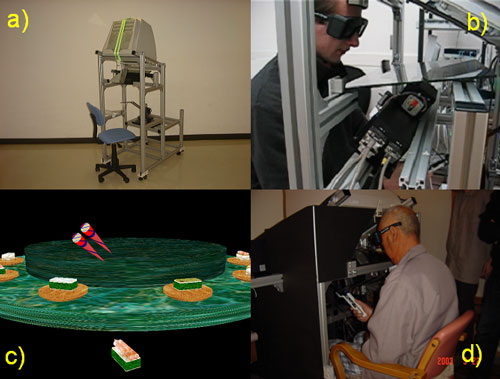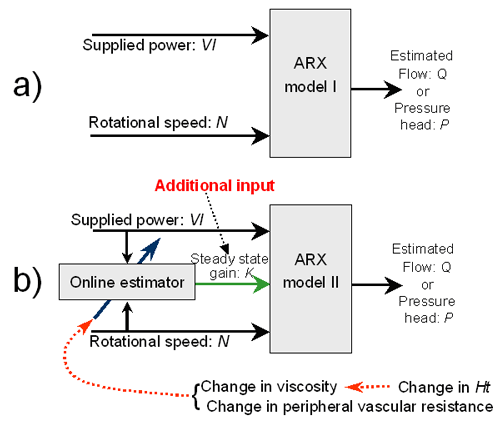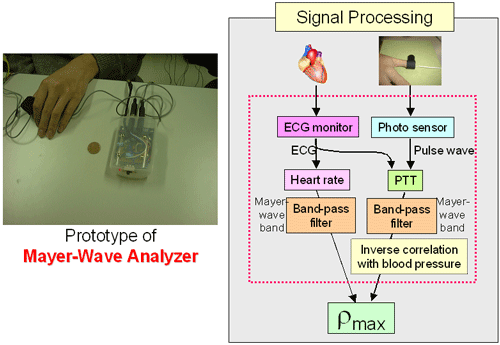HOME > Research Summaries > Cyber-Health Monitoring
Research Summaries

Cyber-Health Monitoring
Makoto Yoshizawa
Professor
Research Division on Advanced Information Technology, Cyberscience Center
E-mail:![]()
Abstract
Our laboratory has proposed cyber-health monitoring whose purpose is to accelerate innovations of intelligent health monitoring systems by applying synergetic effects of advanced ICT. We aim at developing distributed sensor systems for health maintenance, estimation algorithm of physical condition, control and monitoring systems of in vivo medical units, and virtual reality systems for rehabilitation.
1. Introduction
One of the most important issues in the new century is how to suppress the coming inflation of medical cost caused by Japan's rapidly aging society. Not only Japan but also major countries with the trend toward nuclear families such as China will inevitably face the same problem. Moreover, concentration of population in urban areas and declination in population in rural areas are accelerating health disparity.
Progress in nursing-care services for elderly people based on the nursing-care insurance system and the launch of special medical screening system for prevention of lifestyle-related diseases would contribute to medical cost suppression. However, we should develop a more effective strategy.
A key to solving this problem must become information and communication technology (ICT). A near future ICT environment in which many homes use optical fiber communication and individuals have cellular phones with high-speed transmission over 100 Mbps will play a very important role in health maintenance, diseases prevention, and establishment of an effective and ubiquitous medical environment.
To cope with this situation, our laboratory has proposed cyber-health monitoring whose purpose is to accelerate innovations of intelligent health monitoring systems by applying synergetic effects of advanced ICT. We aim at developing distributed sensor systems for health maintenance, estimation algorithm of physical condition, control and monitoring systems of in vivo medical units, and virtual reality systems for rehabilitation.
2. Previous and Current Activities
Current research themes are as follows:
1) Medical application of virtual reality (VR)
2) Intelligent control and monitoring of artificial heart
3) Real-time and low-invasive estimation of cardiac function based on solutions of inverse problem
4) Analysis of biological effect of visual stimulation using circulatory system indices
These themes will be introduced in the following.
2.1. Medical application of virtual reality
The theme, "Medical application of virtual reality systems" is to develop a virtual reality system for neurological test and rehabilitation for upper limbs of patients with motor dysfunction caused by brain diseases or spinal cord injury. The system provides a 3D virtual space with visual, somatic sense displays and the measurement system of visual line. This function is useful for testing multisensory processing function and extracting interest and willingness to do rehabilitation from patients.
Figure 1 shows the VR test and rehabilitation system developed in our study. The virtual "Kaiten-zushi" can provide a variable number of objects (pieces of sushi) to be manipulated by the patient and variable directions of the turntable, which can respectively be adapted by the degree of severity and by the neglected region of the visual area of the patient with hemi-spatial neglect. The force display system (PHANToM; SensAble Inc.) is used to feedback somatic sense to the patient when he grasps the sushi. The eye tracking system can display a virtual world depending on the patient's eye sight. For example, if the either half side of the visual area with respect to the patient's viewpoint can be covered, the patient with hemi-spatial neglect will give a different performance by which half side of the visual area is covered.

Fig. 1. VR test and rehabilitation system for patients with hemiplegia.
a)Overview of the system. b)Eye tracking system placed at opposite side of a half mirror.
c)Virtual Kaiten-zushi to be manipulated. d)Experiment with a patient with hemiplegia caused by stroke.
2.2. Real-time and low-invasive estimation of cardiac function based on solutions of inverse problem
The theme, "Real-time and low-invasive estimation of cardiac function based on solutions of inverse problem" aims at providing a noninvasive method for estimating indices of cardiac function, Emax and the pressure-volume area (PVA), on the basis of mathematical and hemodynamic models using noninvasive information on radial arterial pressure, peripheral vascular diameter, aortic pressure, and so on.

Fig. 2. Estimation of flow and pressure head.
2.3. Intelligent control and monitoring of artificial hearts
The theme, "Intelligent control and monitoring of artificial hearts" is to develop new control devices and algorithms for monitoring an artificial heart. The recent result is that we have proposed a new method for estimating of pressure head and blood flow of a continuous flow-artificial heart. The method can contribute to reduction of the number of sensors that is useful for developing a full-implantable artificial heart.
Figure 2 shows the block diagram of the estimation method. Fig. 2a) is a simplest estimator using the autoregressive with exogenous input (ARX) model in which supplied power and rotational speed of the drive motor for the a continuous-flow blood pump. The model can estimate its output: outflow and pressure difference of the pump.
2.4. Analysis of biological effect of visual stimulation using circulatory system indices
The theme, "Analysis of biological effect of visual stimulation using circulatory system indices" deals with development of a new method for prevention of adverse effects of visual stimulation such as epileptic seizure caused by the Pokemon incident or motion sickness. Our previous study indicated that the maximum cross-correlation coefficient from blood pressure to heart rate, ρmax is a good index for evaluating the effects of visual stimulation on humans.
However ρmax needs a considerably expensive and bulky equipment like a tonometric pressure sensor to measure continuous blood pressure. As a substitute for blood pressure, we have adopted the pulse wave transmission time (PTT[ms]). The PTT is defined the length of the time from R-wave of ECG to the rising time of the pulse wave. The PTT depends on the vascular compliance and it is well known that its vale is negatively correlated with the blood pressure. On the basis of the above observation, we have made a noninvasive, compact and inexpensive tool for measurement and analysis of heart rate and PTT in place of blood pressure, called Mayer wave analyzer, using a photo-reflector and an ECG amp as shown in Fig. 3.

Fig. 3. Mayer-Wave Analyzer (Noninvasive, compact and inexpensive tool for measurement and analysis of blood pressure and heart rate).
3. Future Directions
As mentioned above, advanced information technologies of our laboratory have been applied to various items of medical cybernetics lying from clinical neurology to psychophysiology toward Cyber-health monitoring. The key to success of this approach must be experimental validation of the applied system based on a number of test subjects in clinical situation. The problem of cost for realization in clinical use is also important but if the application we are developing has no other alternative, this problem will become not so sever.
The other things we have to try is to create an intelligent database of multivariable time series data obtained from applied systems and to use data-mining techniques to extract clinically meaningful results from the raw data. The networking using wireless technology would also be important and useful to gather many data automatically. To cope with this point, recently we have just begun to develop a new wireless data acquisition system for the Mayer-wave-analyzer described in 2.4, which will be applied in a theater or fieldworks.